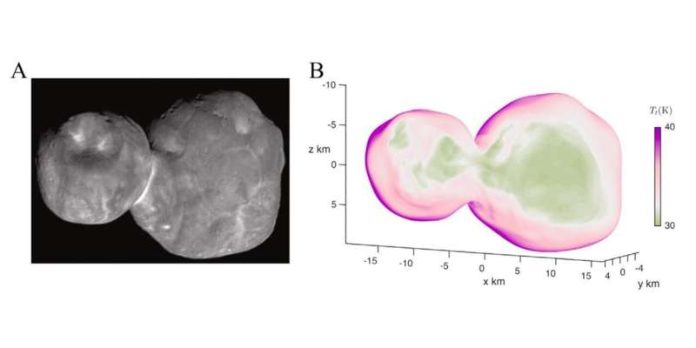
A recent study in the journal Icarus has brought to light new insights about 486958 Arrokoth, a distant object in the Kuiper Belt, and its ability to preserve volatile substances like carbon monoxide (CO).
This research, conducted by Dr. Samuel Birch of Brown University and Dr. Orkan Umurhan from the SETI Institute, suggests that many Kuiper Belt Objects (KBOs) might still hold onto their original volatile ices, contradicting earlier beliefs about how these ancient bodies evolve over time.
Kuiper Belt Objects are like time capsules from the early solar system, and understanding how they manage to retain volatile substances challenges our previous models of their evolution.
Traditional theories struggled to accurately predict the longevity of volatiles on such cold, remote objects, often relying on complex simulations or inaccurate assumptions.
However, Birch and Umurhan’s work introduces a simpler, more accurate model, comparing the retention of gases to the way gas moves through porous rocks.
This research indicates that KBOs, such as Arrokoth, can keep their volatile ices under their surfaces for billions of years. These ices create a sort of underground atmosphere that protects further ice from escaping into space.
The study presents a new way of looking at KBOs, treating them as porous rubble piles composed of CO and water ice, with specific structures that allow CO ice to sublimate (turn from solid to gas) internally. This process forms a protective gas layer that slows down the loss of more volatile substances.
Umurhan emphasizes that this study corrects long-standing misconceptions about the physical nature of KBOs, potentially reshaping theories on comet evolution and activity.
The findings suggest that KBOs could act as “ice bombs,” which become active and exhibit comet-like behaviors when their orbits bring them closer to the sun. This could explain the dynamic outbursts seen in comets like 29P/Schwassmann–Wachmann.
Both Birch and Umurhan are involved in the upcoming CAESAR mission proposal, which aims to further explore cometary bodies and their evolution.
This research not only opens new paths for understanding the origins and nature of comets but also underscores the deep mysteries of our solar system that are yet to be unraveled.
The research findings can be found in Icarus.
Copyright © 2024 Knowridge Science Report. All rights reserved.



